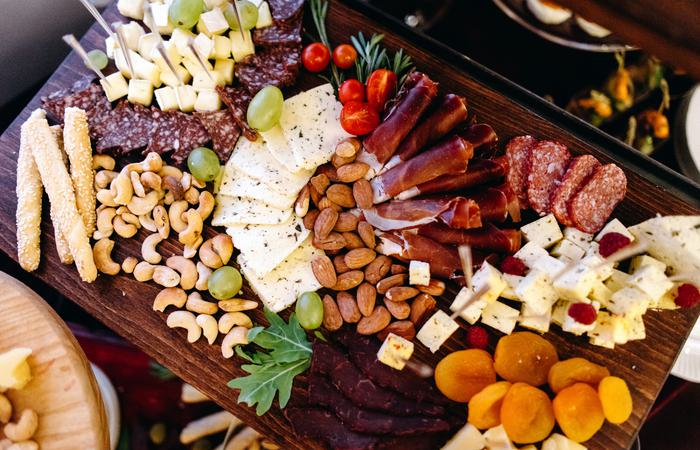
Culinary Sparks – Holiday Inspiration from CuliNEX Chefs
Our new column will appear occasionally throughout the year. Our CuliNEX expert chefs will take the reins to share their thoughts on food – trends, cooking, recipes and more! In this inaugural post, they share a brief history and “how to” of charcuterie boards. Enjoy!
Charcuterie boards have grown in popularity since 2020 with the popular Charcuterie Cottage trends that made the rounds on social media. This year, we’ve seen the rise in the popularity of “Girl Dinner”. It’s been hitting feeds showing mini-platters of snacks of all different varieties. “Girl Dinner” isn’t a charcuterie board, but a charcuterie board could be “Girl Dinner”. Regardless of current trends, charcuterie boards have been around in some form as long as humans have been curing meat, and the accompaniments and combinations are endless and continue to grow every year.
How to Build a Board
There are no official rules for building a complete charcuterie board nor are there specific meats or cheeses that you need to have. As long as you have a selection of cured meat, cheese, pickles, dried fruit, nuts, spreads, and crackers/bread, then you’re set for some delicious flavor combinations. Consider including these:
- Cured Meats: At least 2 meats are recommended and having a variety is nice but prioritize quality over quantity. Prosciutto and salami are good standards but others like sopprasata, capicola or mortadella are great upgrades. This is your base umami profile, and the rest of the board is meant to support or dress up the meats.
- Cheeses: Some combination of a hard cheese and a soft or semi-soft cheese will give a good variety of salty, creamy, savory and sometimes bitter. Parmesan and Manchego are great approachable hard cheeses, but anything aged will bring a lot of flavor to the table. Semi-soft cheeses like cheddars, smoked gouda, or havarti or soft cheese like brie, goat cheese, or blue cheeses also bring a variety of flavors and textures.
- Spreads: Jams, mustards, caramelized onions, bacon jam, pate, honey, hot honey, olive tapenade, or red pepper jelly. Make sure to have a sweet spread and a savory spread – combining them in one bite is one way to elevate the taste experience.
- Pickles: This includes pickles, and anything pickled like cornichons, olives, asparagus, green beans, or carrot slices. Pickles add a little bit of acid to all the fatty and savory flavors which helps brighten other flavors and brings a bit of balance, cutting through the savory, creamy, fatty mouthfeel.
- Dried Fruit/Nuts: This could include cashews, almonds, pecans, pistachios, apricots, cherries, raisins, apple slices. Each of these brings a change in texture – chewy, crunchy, soft, etc.
- Crackers & Breads: Crackers, crostini, pita, naan, breadsticks. A cracker can make or break the entire eating experience. Keep them light, sturdy, and plentiful.
- Additional Fun Ingredients: Grapes or any fruit that are a pop of color without being “wet;” a chocolate element like chocolate covered almond or cherries
Think of building a board like building a bouquet. You have your star piece(s) that you want to shine, and then your supporting ingredients that compliment and pair well with your star(s), and lastly your fillers that fill in the gaps. For example, let’s build a board starting with a holiday favorite – the infamous cheese ball. It’s the star of the dish that we may place in the center of the board, surrounded by supporting items like crackers, meats, and fancy spreads that complement the cheese ball flavor. Once that is complete, the board usually has gaps that can be filled-in with smaller items strewn about. This is when we can add nuts, pickles, grapes, and something sweet like chocolate covered cherries. When building a board remember to include the crowd-pleasing tastes and textures: salty, savory, sweet, sour, dry, juicy, hard, soft, crispy, and creamy. Also think about adding some height – breadsticks can be put standing up in a glass and nuts and fruit can be piled up. Make sure to put spreads, pickles, and anything else “wet” in small bowls or other pretty containers. This will both add visual appeal and height to the board and serve to keep the other food dry.
How to Eat a Charcuterie Board
Charcuterie boards are meant to be a “build your own adventure,” but that adventure can go only as far as one’s willingness to make unconventional flavor combinations. It’s not surprising that a lot of people conform to the basic style of eating a charcuterie board (cracker+meat+cheese) and bypass the spreads or just snack on the pickles and nuts separately from the meats and cheese. It’s fulfilling but is not nearly as exciting as it could be. Sure, a cracker with cheese and salami is delicious, but what if you add a little sweet jam to balance the salty and savory and an olive to clean up the flavors and an almond for crunch? All of the sudden, you’ve made an amuse bouche that not only is savory and salty, but sweet, sour, and also crunchy. Seasoned charcuterie board grazers will look at a charcuterie board and see it more like a family style table with endless combinations and flavor possibilities. In Korean culture, every meal is served with sides called banchan which serve a similar purpose of adding, supporting, or enhancing the meal with different flavors and textures all meant to be combined in the mouth and meant to taste different every time, if desired. This is also seen in Indian cuisine with different chutneys accompanying meals for contrast. You could say that any culture that eats family style meals has a type of ‘charcuterie board,’ if not by ingredient, but by eating experience.
So, we invite you to take the CuliNEX challenge this holiday season: make new taste combinations when you are snacking on your next charcuterie board. You’ll be so happy you did. Happy Holidays!








